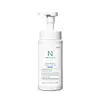What's inside
What's inside
 Key Ingredients
Key Ingredients

 Benefits
Benefits

 Concerns
Concerns

 Ingredients Side-by-side
Ingredients Side-by-side

Water
Skin ConditioningButylene Glycol
HumectantGlycerin
HumectantHydrogenated Polyisobutene
EmollientGlyceryl Stearate
EmollientPearl Extract
AntioxidantHydrogenated Lecithin
EmulsifyingC14-22 Alcohols
Emulsion StabilisingPEG-100 Stearate
Ammonium Acryloyldimethyltaurate/Vp Copolymer
Anhydroxylitol
HumectantArgania Spinosa Kernel Oil
EmollientCaprylyl Glycol
EmollientPhenoxyethanol
PreservativeEthylhexylglycerin
Skin ConditioningPotassium Hydroxide
BufferingParfum
MaskingDisodium EDTA
Water, Butylene Glycol, Glycerin, Hydrogenated Polyisobutene, Glyceryl Stearate, Pearl Extract, Hydrogenated Lecithin, C14-22 Alcohols, PEG-100 Stearate, Ammonium Acryloyldimethyltaurate/Vp Copolymer, Anhydroxylitol, Argania Spinosa Kernel Oil, Caprylyl Glycol, Phenoxyethanol, Ethylhexylglycerin, Potassium Hydroxide, Parfum, Disodium EDTA
Water
Skin ConditioningDisodium Laureth Sulfosuccinate
CleansingDisodium Cocoamphodiacetate
CleansingGlycerin
HumectantSodium Methyl Cocoyl Taurate
CleansingSorbitol
HumectantDisodium Cocoyl Glutamate
Cleansing1,2-Hexanediol
Skin ConditioningButylene Glycol
HumectantSodium Hyaluronate
HumectantHyaluronic Acid
HumectantHydrogenated Lecithin
EmulsifyingCeramide NP
Skin ConditioningCitric Acid
BufferingPolyglyceryl-10 Laurate
Skin ConditioningPolyglyceryl-10 Myristate
Skin ConditioningMethyldihydrojasmonate
MaskingDipropylene Glycol
HumectantIsopropyl Myristate
EmollientJuniperus Mexicana Wood Oil
PerfumingCitrus Sinensis Peel Oil Expressed
PerfumingCyclamen Aldehyde
Masking3-Hexenol
MaskingCitrus Aurantium Bergamia Fruit Oil
MaskingGamma-Undecalactone
PerfumingXylitylglucoside
HumectantAnhydroxylitol
HumectantOctyldodecanol
EmollientXylitol
HumectantCaprylyl Glycol
EmollientDisodium EDTA
Phenethyl Alcohol
MaskingWater, Disodium Laureth Sulfosuccinate, Disodium Cocoamphodiacetate, Glycerin, Sodium Methyl Cocoyl Taurate, Sorbitol, Disodium Cocoyl Glutamate, 1,2-Hexanediol, Butylene Glycol, Sodium Hyaluronate, Hyaluronic Acid, Hydrogenated Lecithin, Ceramide NP, Citric Acid, Polyglyceryl-10 Laurate, Polyglyceryl-10 Myristate, Methyldihydrojasmonate, Dipropylene Glycol, Isopropyl Myristate, Juniperus Mexicana Wood Oil, Citrus Sinensis Peel Oil Expressed, Cyclamen Aldehyde, 3-Hexenol, Citrus Aurantium Bergamia Fruit Oil, Gamma-Undecalactone, Xylitylglucoside, Anhydroxylitol, Octyldodecanol, Xylitol, Caprylyl Glycol, Disodium EDTA, Phenethyl Alcohol
Ingredients Explained
These ingredients are found in both products.
Ingredients higher up in an ingredient list are typically present in a larger amount.
This ingredient is created from dehydrating xylitol in acidic conditions. Xylitol is a famous sugar and humectant.
Much like its predecessor, anhydroxylitol is a humectant. Humectants attract and hold water to moisturize the skin.
This ingredient is most commonly found in a popular trio called Aquaxyl. Aquaxyl is made up of anhydroxylitol (24 - 34%), xylitylglucoside (35 - 50%), and xylitol (5 - 15%).
According to a manufacturer, Aquaxyl is known for a 3-D hydration concept and an anti-dehydration shield to reinforce the outer layer of skin.
This ingredient is often derived from plants such as wood and sugarcane.
Learn more about AnhydroxylitolButylene Glycol (or BG) is used within cosmetic products for a few different reasons:
Overall, Butylene Glycol is a safe and well-rounded ingredient that works well with other ingredients.
Though this ingredient works well with most skin types, some people with sensitive skin may experience a reaction such as allergic rashes, closed comedones, or itchiness.
Learn more about Butylene GlycolCaprylyl Glycol is a humectant and emollient, meaning it attracts and preserves moisture.
It is a common ingredient in many products, especially those designed to hydrate skin. The primary benefits are retaining moisture, skin softening, and promoting a healthy skin barrier.
Though Caprylyl Glycol is an alcohol derived from fatty acids, it is not the kind that can dry out skin.
This ingredient is also used as a preservative to extend the life of products. It has slight antimicrobial properties.
Learn more about Caprylyl GlycolDisodium EDTA plays a role in making products more stable by aiding other preservatives.
It is a chelating agent, meaning it neutralizes metal ions that may be found in a product.
Disodium EDTA is a salt of edetic acid and is found to be safe in cosmetic ingredients.
Learn more about Disodium EDTAGlycerin is already naturally found in your skin. It helps moisturize and protect your skin.
A study from 2016 found glycerin to be more effective as a humectant than AHAs and hyaluronic acid.
As a humectant, it helps the skin stay hydrated by pulling moisture to your skin. The low molecular weight of glycerin allows it to pull moisture into the deeper layers of your skin.
Hydrated skin improves your skin barrier; Your skin barrier helps protect against irritants and bacteria.
Glycerin has also been found to have antimicrobial and antiviral properties. Due to these properties, glycerin is often used in wound and burn treatments.
In cosmetics, glycerin is usually derived from plants such as soybean or palm. However, it can also be sourced from animals, such as tallow or animal fat.
This ingredient is organic, colorless, odorless, and non-toxic.
Glycerin is the name for this ingredient in American English. British English uses Glycerol/Glycerine.
Learn more about GlycerinHydrogenated Lecithin is created from the hydrogenation of lecithin (a group of phospholipids). Hydrogenation is a chemical reaction between hydrogen and another element.
This ingredient is an emollient and emulsifier. As an emollient, it helps soften skin by trapping moisture within. As an emulsifier, it prevents oil and water ingredients from separating.
Water. It's the most common cosmetic ingredient of all. You'll usually see it at the top of ingredient lists, meaning that it makes up the largest part of the product.
So why is it so popular? Water most often acts as a solvent - this means that it helps dissolve other ingredients into the formulation.
You'll also recognize water as that liquid we all need to stay alive. If you see this, drink a glass of water. Stay hydrated!
Learn more about Water